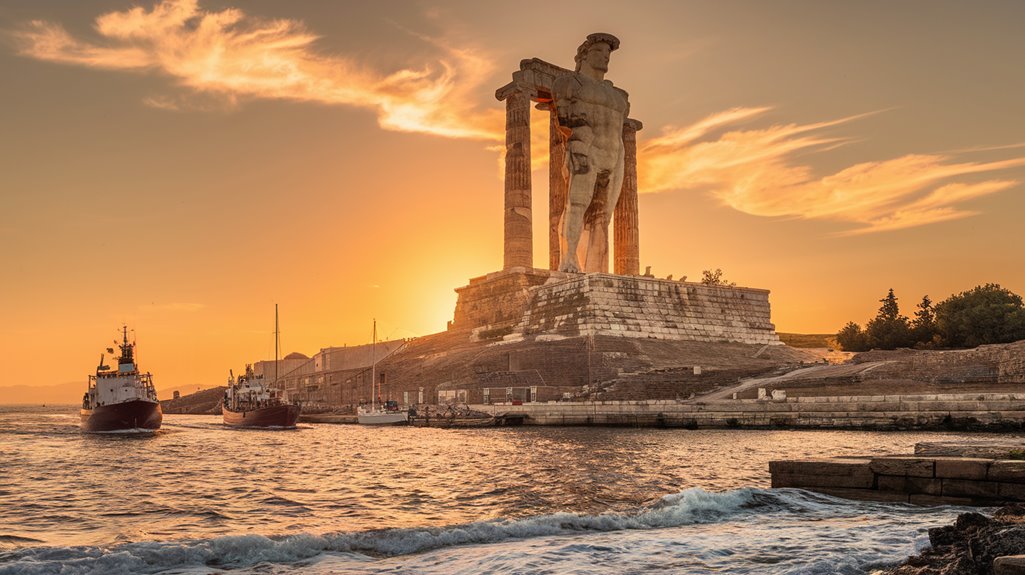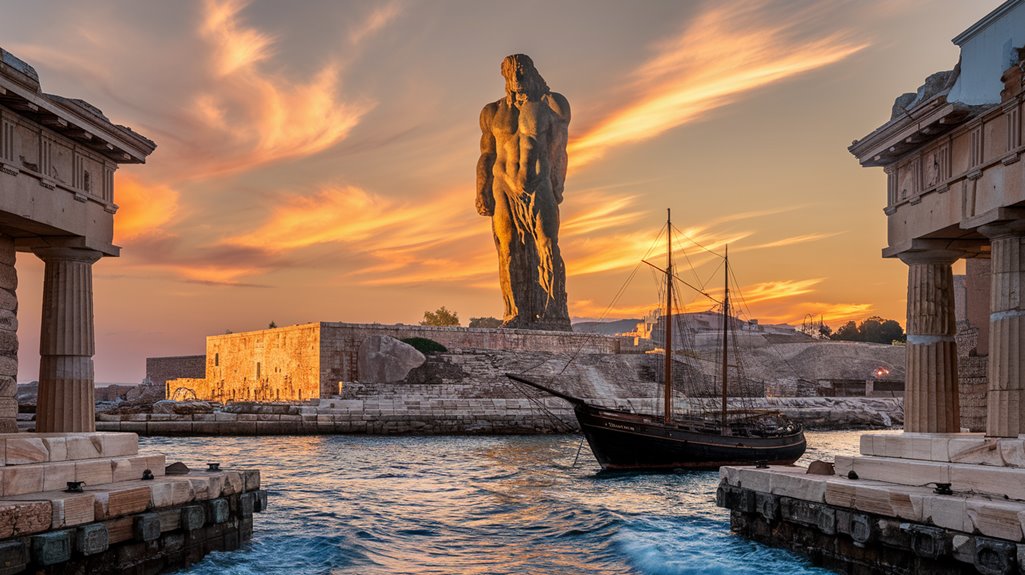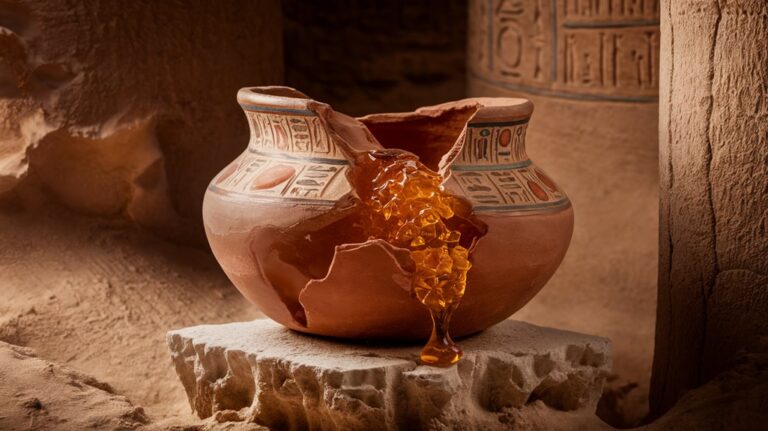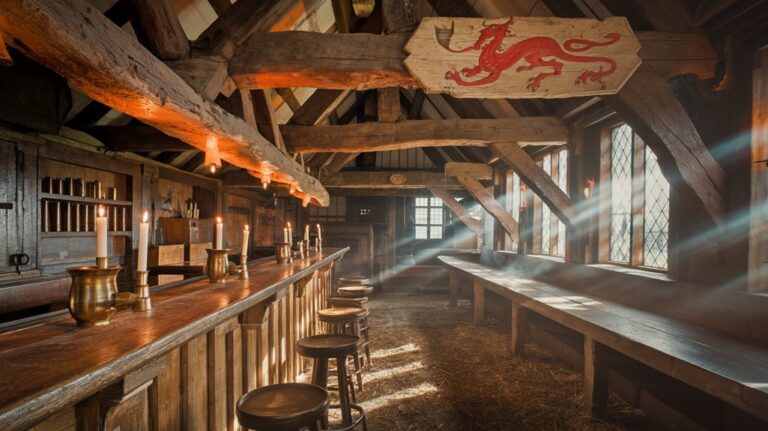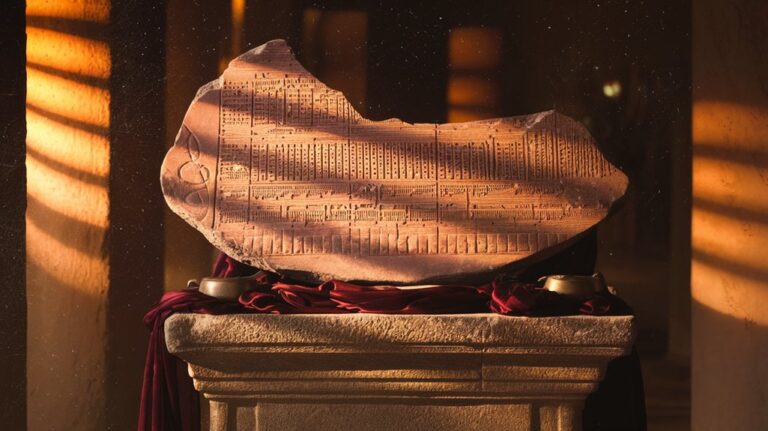The Colossus of Rhodes Stood for Only 55 Years
You've probably heard of the Colossus of Rhodes as one of the Seven Wonders of the Ancient World, but its brief existence might surprise you. While modern landmarks often stand for centuries, this massive bronze statue of Helios lasted merely 55 years before crashing down in an earthquake. Yet in that short span, it managed to become one of history's most celebrated monuments. The story behind its rise and fall reveals fascinating insights about ancient ambition, engineering, and fate.
The Pride of Ancient Rhodes: Why It Was Built
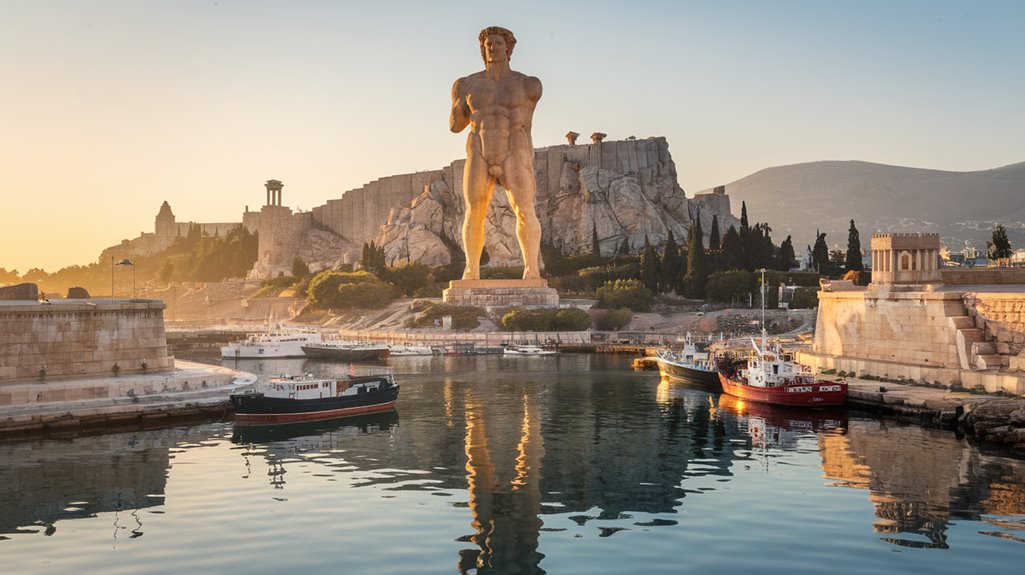
Victory and defiance shaped the creation of the Colossus of Rhodes, one of the most ambitious monuments of the ancient world.
You'll find its historical context rooted in the aftermath of Alexander the Great's death, when his generals fought for control of his empire. When Antigonus I Monophthalmus tried to conquer Rhodes in 305 BCE, the city's successful defense, aided by Ptolemy I of Egypt, became a defining moment.
The cultural significance of this massive statue ran deep. Built to honor Helios, the patron god of Rhodes, it was funded by selling the abandoned siege equipment of the defeated army for 300 talents. Under the direction of Chares of Lindos, construction of this masterpiece began in 292 BCE. The ambitious project would require twelve years to complete.
You're looking at more than just a monument – it was a symbol of Rhodes' independence, prosperity, and religious identity, standing as a testimony to the city's triumph against powerful forces.
Engineering Marvel: Construction Methods and Materials
The engineering prowess behind the Colossus of Rhodes showcased ancient Greek innovation at its finest. The construction techniques combined iron framework, stone columns, and bronze plates of varying thickness to create a structurally sound monument. Craftsmen melted down Greek battle weapons to create the statue's magnificent bronze exterior.
You'll be amazed to learn that craftsmen used sophisticated material choices, including thicker bronze plates at the joints and a white marble pedestal as the base.
The builders employed three groundbreaking methods that still impress engineers today:
- Cast large sections separately using sand-casting and lost-wax processes
- Built earthen embankments around completed sections to maintain level working grounds
- Assembled modular pieces systematically, joining them to create the colossal structure
While these methods were revolutionary, the statue's ultimate collapse during an earthquake revealed the limitations of ancient engineering capabilities. The statue took twelve years to construct, requiring immense dedication and resources from the Rhodian people.
Size and Scale: Breaking Down the Numbers
Standing approximately 33 meters (108 feet) tall, ancient Rhodes' magnificent Colossus ranked as the tallest statue of its time.
When you consider the height variations reported by different historical sources, you'll find estimates ranging from 105 to 230 feet, though most scholars accept the lower figure. The statue's height was originally recorded as 70 cubits, and while ancient measurements like the cubit weren't completely standardized, this translates to roughly 105-110 feet using an 18-inch cubit conversion.
Including its base, you'd have seen the Colossus towering about 460 feet above sea level, creating an awe-inspiring sight for approaching ships.
Ancient writers like Philo, Strabo, and Pliny documented similar heights, helping modern historians reach these consensus measurements.
This masterpiece of engineering was constructed entirely of cast bronze materials, making it a remarkable feat of ancient metallurgy.
The statue's construction took twelve years to complete, funded by the spoils of war after Rhodes' victory over Antigonus.
Location Mystery: Where Did It Really Stand?
Precisely where the magnificent Colossus of Rhodes once stood remains one of antiquity's most debated mysteries.
While popular culture often depicts it straddling Mandraki Harbor's entrance, archaeological debates have dismissed this as mere myth. Multiple location theories have emerged, with recent research pointing to Monte Smith on the Acropolis as a more likely site.
You'll find three compelling reasons why historians now favor the Acropolis theory:
- The solid limestone foundation could better support the massive structure
- Its placement near sacred temples of Athena and Zeus aligns with religious significance
- The elevated position would've protected it from military attacks
Archaeological discoveries of bronze workshops in Rhodes have provided valuable insights into the statue's construction methods and potential location. Despite these theories, you won't find definitive archaeological evidence pinpointing the exact location, as centuries of landscape changes and limited historical records continue to challenge researchers' efforts to solve this ancient puzzle. The statue's eventual collapse in 222 BC during an earthquake only complicated efforts to determine its original placement.
The Short-Lived Wonder: Its Tragic Demise
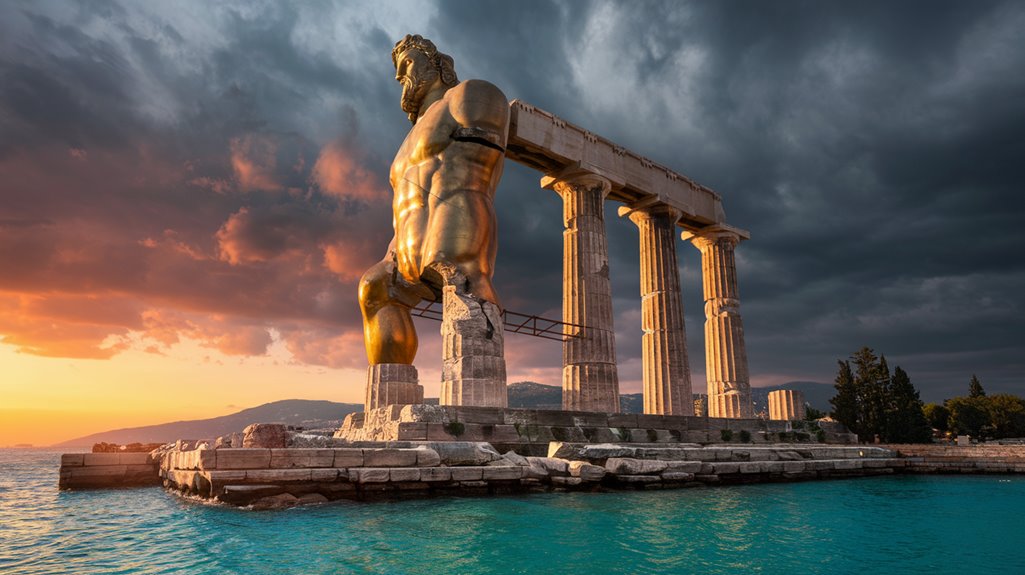
Despite its awe-inspiring presence, Rhodes' magnificent Colossus endured for just 54 years before meeting a catastrophic end in 226 BCE. A powerful earthquake struck the island, causing the massive statue to buckle at its weakest point – the knees – and crash onto the mainland, not into the harbor as popular legends suggest. The remnants of the fallen statue were so substantial that they required 900 camel loads to transport when sold.
While Ptolemy III offered to finance its reconstruction, religious influences led the Rhodians to decline. The Oracle of Delphi's mythical interpretations suggested that the collapse was divine punishment for offending Helios, the patron god.
As Rhodes later embraced Christianity in the 4th century, any hopes of rebuilding the pagan monument faded. The fallen remains lay untouched for centuries until Arab forces allegedly melted them down in 653 CE, marking the final chapter of this short-lived wonder.
Legacy and Modern Attempts at Recreation
While the original Colossus no longer stands, its influence continues to captivate architects and dreamers worldwide. Like its ancient predecessor that was constructed in 280 B.C., these new proposals seek to celebrate triumph and innovation. Its cultural impact resonates through centuries of art, literature, and architectural ambitions, serving as a modern symbolism of human achievement and resilience.
The new design's interior would house a massive cultural center, complete with a museum, library, and exhibition spaces to showcase Greek heritage.
You'll find the Colossus's enduring legacy reflected in multiple ambitious proposals for its recreation, including:
- A 2008 plan to rebuild the wonder at Rhodes' harbor entrance
- A 2015 proposal for a 150-meter cultural center with solar-powered lighthouse
- An alternative 400-foot design featuring golden solar panels and earthquake-resistant technology
Despite the estimated $283 million price tag and logistical challenges, these modern visions aim to honor the ancient wonder's spirit while incorporating sustainable technology.
Though the original's exact location remains debated, its influence continues inspiring bold architectural dreams.

